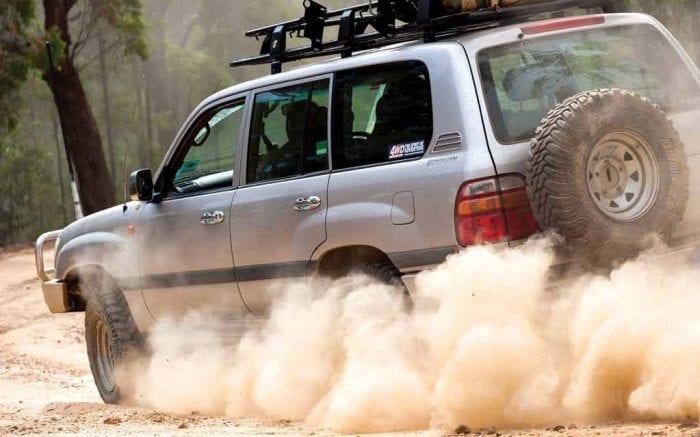From the archives – SHOCK VALUE: The No-Bull test
Friday, 25 May 2018We’ve taken the leading brands of shock absorbers and put them through the biggest no-bull, real-world VALUE comparo yet!
We pulled this article from the 2011 archives for its comprehensive nature. Below you can read excerpts from the article, click here to read the full article written by Paul Zielinski that appeared in issue 165 of 4WDAction magazine in 2011.
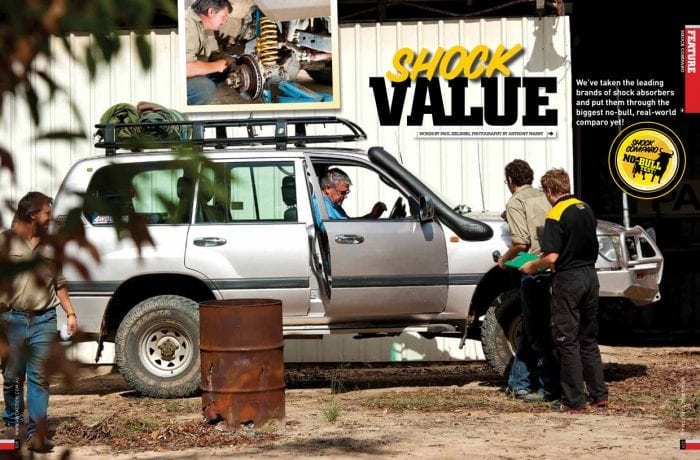
Undoubtedly, the humble shock absorber is one of the most underrated components in a 4WD’s suspension. Off-road your 4WD’s suspension, in particular the shock absorbers, is under enormous forces, rapidly moving up and down. Without a set of shocks fitted, you’d be lucky to drive little more than 50m before the vehicle was overcome by an uncontrollable bounce. With this in mind, we’ve undertaken a comprehensive no-bull shock absorber comparo to help you get the most out of your 4WD’s set-up. This comparo focuses on real world and controlled environment testing on nine leading brands of 4WD shock absorbers to see how they stack up. Just how well do each of the shocks handle rough terrain, both on and off-road? Do they give the driver confidence behind the wheel? Is it possible to get a great all-rounder? How bush proof are they? After all, along with the cost, these are all factors that influence our decision when we’re looking to purchase a new set of shocks. Also along for the real-world testing on this comparo, we’ve called on the expert driving skills of Bruce Garland. Bruce is one of only two Aussies to have competed in the Dakar Rally in his highly modified Isuzu D-Max 4WD ute. He’s also racked up an impressive collection of trophies for a number of off-road rallies, including the Australian Safari. He’s definitely one man who knows his way around a 4WD, and more importantly, how they should handle correctly. With Bruce behind the wheel of our 100 Series test vehicle, the shocks had nowhere to hide and were set to get put through their paces. To keep the testing completely objective, we had Bruce test each set of shocks without knowing what brand was fitted each time, we simply recorded his comments on the strengths and weaknesses of each shock along the way. As if the driving leg of this comparo wasn’t enough, we punished each shock on the dyno. Utilising state of the art equipment with a data replay facility, we were able to precisely rerun every bump the shock went through on our test track back on the shock dyno. Each shock was graphed for performance before and after the run to determine if shock fade was a factor. So sit back as we tackle the biggest shock comparison test we’ve ever done!
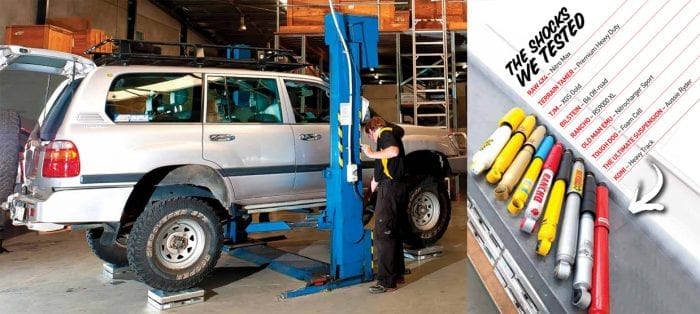
So we could focus solely on the performance differences in each shock, we eliminated as many variables as possible throughout the testing process. For the real-world testing in this comparo, we used the 4WD Action Toyota LandCruiser 100 Series as the test vehicle. It’s the 4.5L petrol-powered auto model and has solid axles front and rear. The ’Cruiser is a typical 4WD with a number of accessories to help it along in the bush. It’s fitted with steel front and rear bars, rear wheel carrier, long-range tank (180L aftermarket sub tank + 90L factory main tank). It’s also fitted with a roof cage, rear cargo drawers and 285/75 R16 Copper STT tyres wrapped around a set of steel wheels. On the suspension side of things, we had a new set of heavy duty 2in lift King Springs that were fitted by the guys out at Wholesale Suspension in Penrith. The team also thoroughly checked over the ’Cruiser to ensure everything was in top shape prior to the testing getting underway. This way we could compare the performance of each set of shocks closely, knowing the ’Cruiser’s suspension components remained consistent during the test and worn parts were not influencing the ride quality.
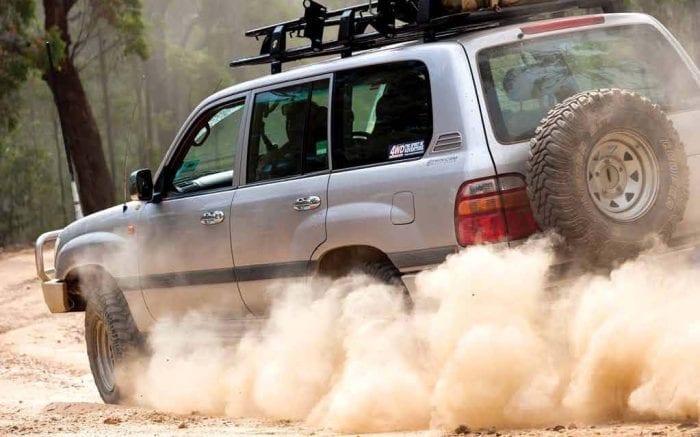
WHAT YOUR SHOCKS REALLY DO
No matter what springs are under your vehicle, the shocks will be working surprisingly hard to limit the effects of rough terrain back through the vehicle. While the springs ultimately support the weight of the vehicle, shocks are what control the energy from your springs as your vehicle moves over any bumps. The shock absorber’s main role is to slow down and control the movement of your vehicle as the suspension travels through its full range of movement. A good shock will be able to control wheel movement over bumps while keeping the tyre in contact with the ground, within the limits of your suspension travel that is! At touring speeds, controlling spring movement is no easy feat. Every bump that’s felt from inside the vehicle will be cushioned significantly by your springs and shocks. If the shocks aren’t up to the task, you’ll find most 4WDs will be dancing all over the track. Not only will worn shocks make for an uncomfortable experience for everyone on-board, but it makes travelling at any speed dangerous. There’s a fine line that shock absorber engineers balance when designing a shock to get the maximum amount of control without jeopardising comfort. Countless hours of R&D are invested by shock manufacturers to refine the shock’s performance to suit each vehicle and application. It’s this balance of control and comfort that defines a good shock absorber.
BEHIND THE COLOURFUL PAINT
As with many 4WD products, there are various designs and features that set out to achieve a similar result – shocks are no exception. Within the range of shocks we had for this comparo, we had a mix of mono-, twin and triple-tube design shocks, shim, spring and needle valving, and both adjustable and fixed valving, high- and low-pressure gas charge and a variety of bush materials and hardness. Before we get too carried away with the testing leg of this comparo, let’s take a close look at what all these differences really mean.
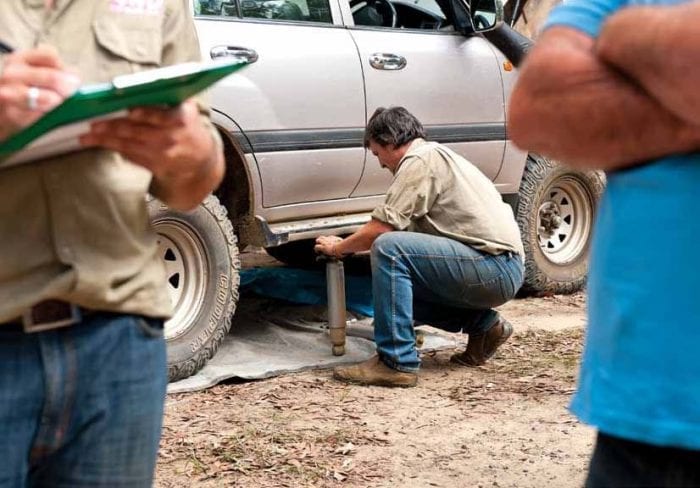
CONTROLLING THE BOUNCE
Shock absorbers need to be able to control suspension movement over a range of different speeds and terrains. They convert kinetic energy, or movement, from the vehicle’s suspension as it reacts to bumps into thermal energy, or heat. The harder a shock works to control your 4WD’s suspension, the more heat that it will generate. To be able to control your 4WD well, there are a number of factors that are calculated into the R&D process before a shock becomes suitable for a specific vehicle and the intended application. Bump and rebound are two forms of movement that a shock absorber is subjected to. Bump (or compression) is any movement where the wheel is travelling up into the guard, closing the shock. Rebound is the term given to movement of the wheel away from the guard, opening up the shock. Rebound also factors in energy from the spring as it tries to return to its normal ride height after a bump. How well shocks control these two movements is only half the battle a shock absorber has to face. Shocks are subject to high- and low-speed movement in both directions, which is totally independent of vehicle speed. High-speed shock movement is any sharp, rapid road condition the shock has to react to, like a tree root along the track or corrugations. The shock must be able to control the rapidly moving spring, without allowing the vehicle to skip all over the track. Low-speed shock movement occurs whenever the shock is moving slowly, like when travelling over crests and dips in the road. A shock that’s too soft in low-speed control can often let the vehicle continue to bounce after a large bump. Different styles of springs, whether coils, leaves, torsion bars or even airbags, all react in slightly different ways over bumps. For example, a coil will want to bounce freely after being compressed, whereas a leaf spring develops more resistance from the leaf-pack when returning to its original position. This sees each suspension set-up demanding a specific valving to help control the vehicle. One shock is not interchangeable with different vehicles just because it’s the same length. The amount of pressure it takes to move a shock at each of these four key movements comes down to valving design that the manufacturer settles on to suit each vehicle.
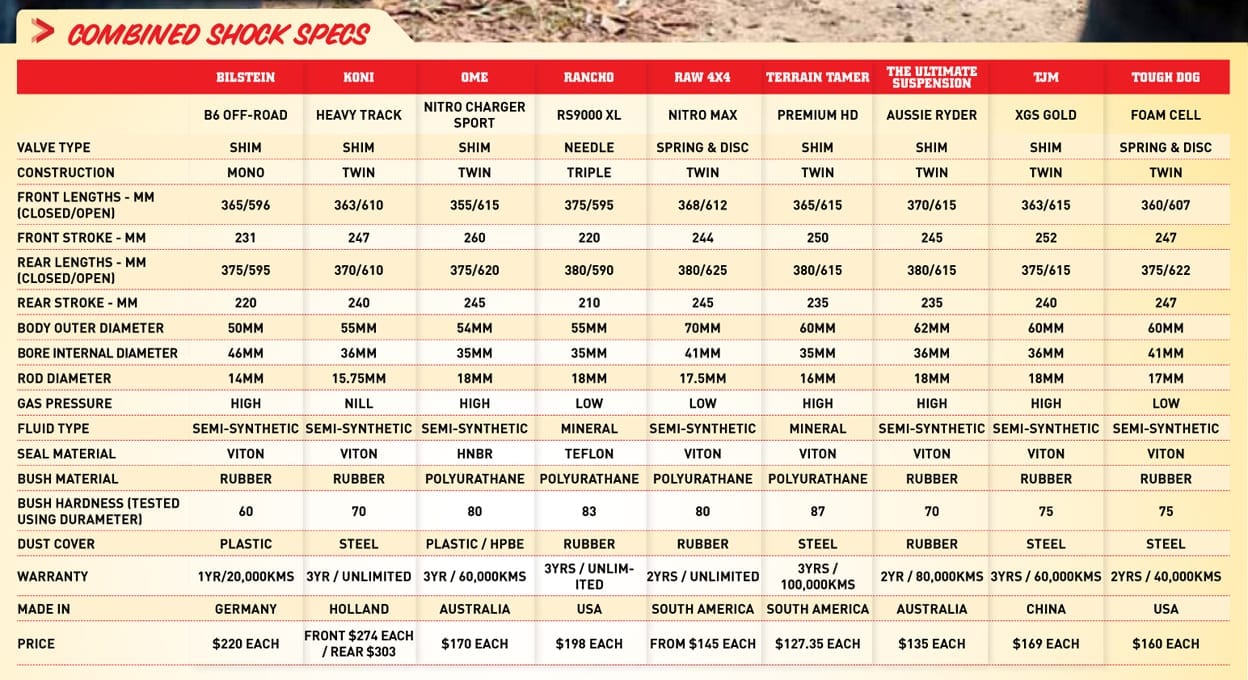
HOW WE TESTED THEM
REAL-WORLD TESTING
Many 4WDers will have an idea of what their preferred level of comfort is. What can’t be denied is the feedback from the driver’s seat from a shock that is able to give good control on and off the road. The key to a good shock is a balance of control and comfort that ultimately creates a safer 4WD. With this in mind, we set out to push each shock through a series of driving tests that would most certainly expose both the strengths and weaknesses of each shock. During the week of real-world testing, the ambient temperature was the only variable outside of our control. We must have had the weather gods on our side for this comparo, as the average daily temperature only varied from 22°C to 26°C from the start to the finish. To keep testing as objectively as possible, Bruce was kept aside as Wayne Murphy from Mad Fab installed each set of shocks. This way each real-world test was done as a ‘blind’ test, eliminating any prior expectations from the results. With the dedicated test track, Bruce behind the wheel and myself riding shotgun, we were able to build one of the most consistent back-to-back shock tests yet! We’ve put the results together under the rundown on each shock later in the article. So for now, let’s take a look at the test track and run through what each shock had to deal with once they were fitted to the ’Cruiser.
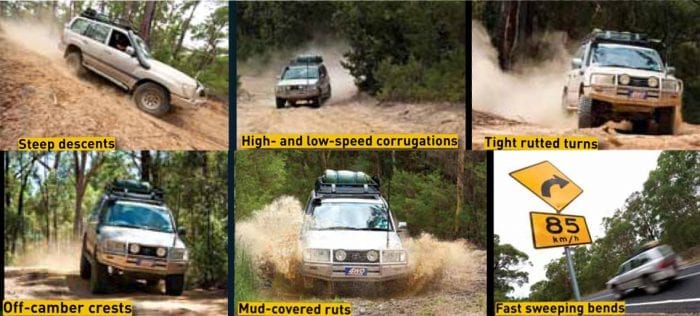
OUT ON THE TRACK
Covering as many terrains as possible in close proximity was always going to be a difficult task for this comparo. To maximise the most amount of variation in terrain as we could, we locked in a week of testing at an off-road racing circuit. We pieced together a 15km off-road loop that covered the most common terrain that we all see with the hubs locked. The track we had planned took in everything from high-speed corrugations and off-camber humps to slow rocky hill climbs that really got the suspension moving. Following the off-road track, we covered a 25km on-road section that had a mix of tight sweeping turns along with high-speed straights to gauge how the shocks impact on the on-road handling. After all, we spend a reasonable amount of time travelling on the blacktop between tracks. The object of the dedicated off-road test track was to replicate the same conditions for every shock. This way we could directly compare how each set of shocks handled specific sections and obstacles on the track. Being the only vehicle on the track, we were able to follow the same wheel tracks for each test without being interrupted by any other vehicles. Two loops of the dedicated off-road test track were covered for each set of shocks, with the top four performers refitted for a shootout. The first loop of the track was taken at a general touring pace. We set a target time of 10 minutes to keep the speed of each run consistent. The aim was to travel at the pace an owner would drive after just purchasing their new 4WD. On the second loop, we asked Bruce to step it up a notch, taking a slightly quicker pace. This second run aimed to push the shocks to their limits and replicated a slightly more demanding driving style. This run had a target time set of eight minutes. Both loops were driven back to back with individual shock temperatures noted after each run. From these on- and off-road tests, we were able to establish the different characteristics each shock had and the overall influence on the body language of the truck, which we’ll outline in the rundown of each brand.
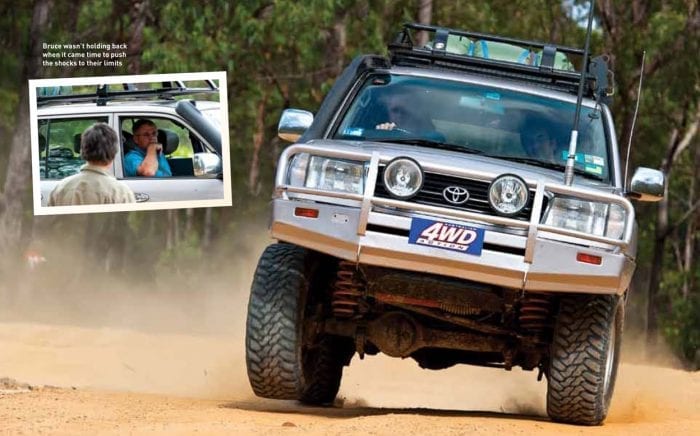
CONTROLLED ENVIRONMENT TESTING
SHOCK DYNO TESTING
The real-world testing brought out significant differences in each shock’s performance that were noticeable from inside the vehicle. To top off this comparo, we wanted to see how each shock was really affected by the heat generated during the off-road leg of our test. To do this, we tracked down a state-of-the-art shock dyno that was able to capture and replay the exact terrain we used for our off-road test track. By hooking up a displacement sensor to one of the shocks during the real-world testing, we were able to record the two off-road loops. The first touring pace loop of the track, as well as the slightly quicker second loop, were recorded back to back. The data we collected was then able to be replayed on the dyno once we were back in the workshop. A rear shock from each brand was loaded on the dyno one after the other and run through a standard cold performance test to gauge the base values for the shock. The dyno then replayed the first off-road loop, followed by the quicker second off-road loop back to back. Once the punishment from the two off-road loops had finished, we re-ran the standard performance test to establish if the shock had degraded once it was hot. It’s one thing being inside a vehicle in harsh off-road conditions, but seeing what the shocks are subjected to back on the dyno is enough to give any self-respecting 4WDer cold shivers.
WHAT TO LOOK FOR
When you’re looking over the performance graphs, there are a few things to look out for. During the performance test, the dyno cycles the shock over a set stroke at nine different speeds – from 0.05m/s (meters per second) to 1m/s. The columns along the bottom of each graph represent each of the nine test speeds, 0.05m/s, 0.1m/s 0.2m/s and so on. Their measured forces are displayed as a dot on the graph above each column. The top half of the graph shows the rebound forces and the lower half shows the compression forces. Blue correspond to the cold performance test and red is for its hot test. As a general rule, you will see low forces in the 0.05m/s to 0.2m/s range so the shock remains compliant during low-speed rock crawling situations. From 0.25m/s onwards, the forces will progressively ramp up to control the vehicle at touring speeds. The compression forces are always lower than the rebound, as rebound has to control the spring’s urge to return back to its original height after a bump in the road. We’ve also measured shock temperatures at the completion test. While the difference is displayed as a percentage of change from start to finish, things such as oil volume, twin or mono-tube design and how firm the valving is tuned all influence how heat will affect the shock.
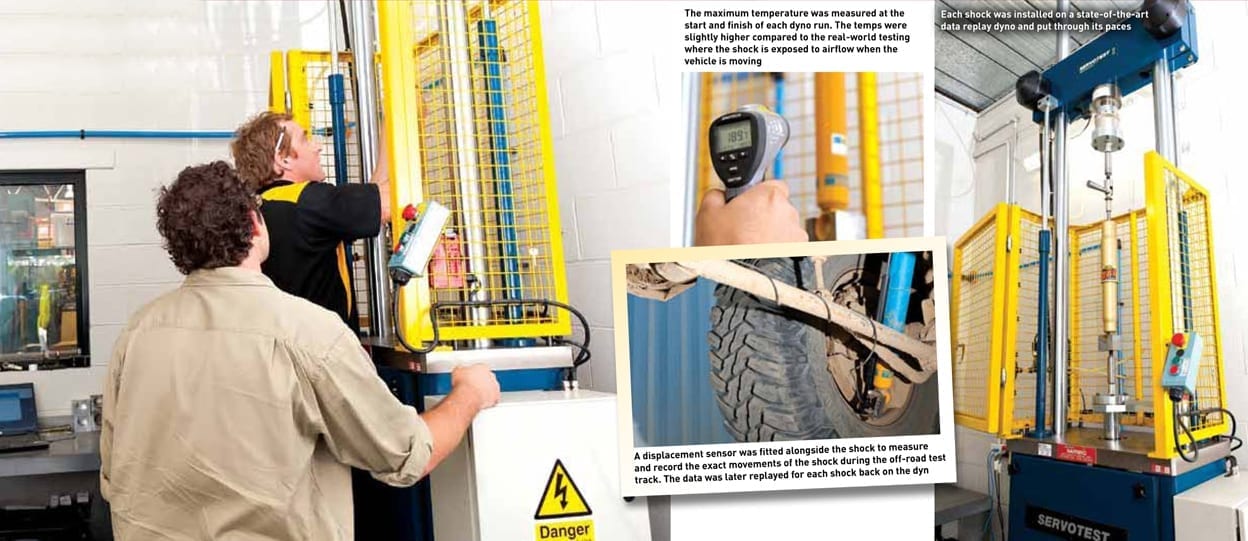
HOW THEY STACKED UP
SHOCK NAME: BILSTEIN
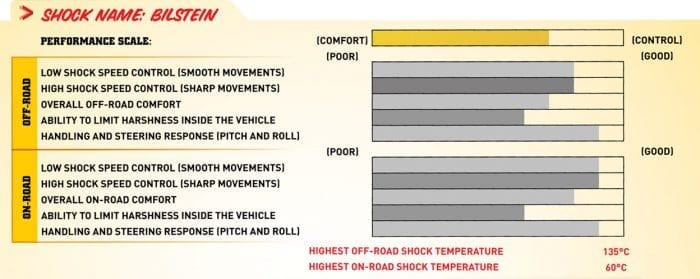
BRUCE’S OPINION: Braking and steering inputs proved responsive with this shock fitted. There was very minimal pitching and diving as I pushed the ’Cruiser hard on the second loop. Both off-road and particularly on-road characteristics were also improved, giving a great deal of confidence back to the driver at touring speeds. Overall, this shock is a great driver’s shock if you can deal with a slightly firmer ride.
SHOCK NAME: KONI
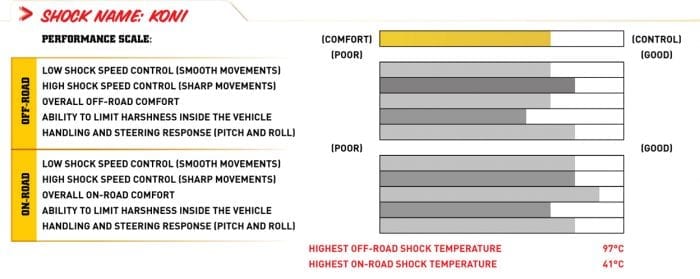
BRUCE’S OPINION: These shocks gave a slightly firm but direct ride back through the vehicle. While they were a little firmer than most off-road, they still remained comfortable over the bumps and managed to control both bump and rebound confidently in situations that left other shocks wondering. As a trade-off to the slightly firmer ride, you develop some very favourable handling characteristics from behind the wheel. From my point of view, the steering inputs were very direct and allowed for good feedback to the driver. They proved to give a very predictable ride both on and off-road.
SHOCK NAME: OLD MAN EMU
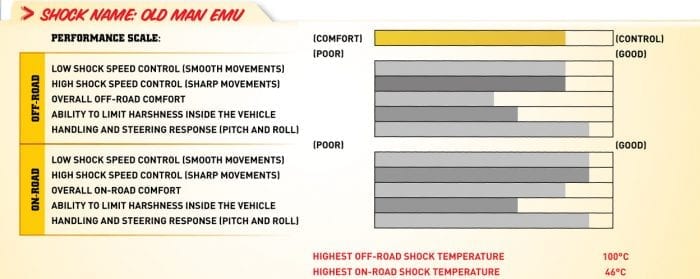
BRUCE’S OPINION: These shocks held up superbly over the first and second off -road test, maintaining a consistent feel from inside the vehicle over every terrain. The ride was noticeably stiffer than most other shocks, but this is always going to be a trade-off for a high level of control on the track. On-road, they were one of the most direct and responsive sets of shocks in the test. They showed terrific on-road manners, especially as weight shifted in the transition between left and right bends at speed.
SHOCK NAME: RANCHO
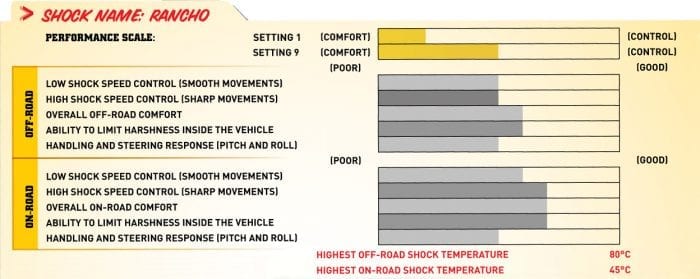
BRUCE’S OPINION: Surprisingly, even when Wayne adjusted these shocks set to their firmest setting, they still allowed a significant amount of body movement, particularly when weight shifted from side to side when changing directions between corners and under braking. Being on the soft side, it did take away some driver confidence at touring speeds, on and off-road. This shock would be best suited to low speed off-road work and may w ell be more at home on a lighter vehicle.
SHOCK NAME: RAW NITRO MAX
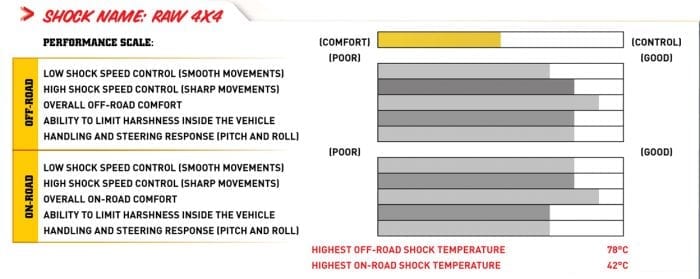
BRUCE’S OPINION: This set of shocks did well to control the vehicle, always maintaining a high level of comfort and grip on the track. From inside the vehicle, it always felt comfortable as the shocks soaked up the tough sections of our test track. Over smooth large bumps, they did allow the ’Cruiser develop slightly more rebound compared to others in the test. Overall, these are a well-balanced shock.
SHOCK NAME: TERRAIN TAMER
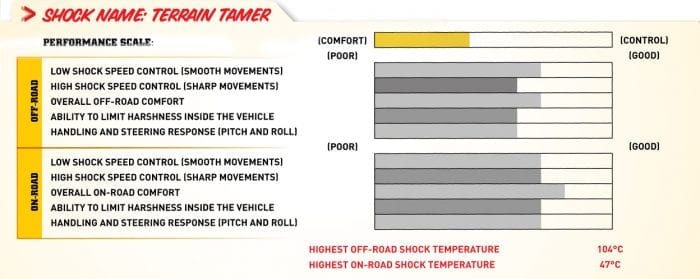
BRUCE’S OPINION: These shocks gave fairly even feedback over the various terrains we cove re d in the off-road test track. Off-road, the shocks allowed the vehicle to develop as light wallow when weight was transferred from side to side over off-camber crests, which did upset the handling slightly more than others in the test. For one of the softer-feeling shocks in the test, they had good on- road manners and were more than capable of controlling the ’Cruiser at touring speeds.
SHOCK NAME: THE ULTIMATE SUSPENSION – AUSSIE RYDER
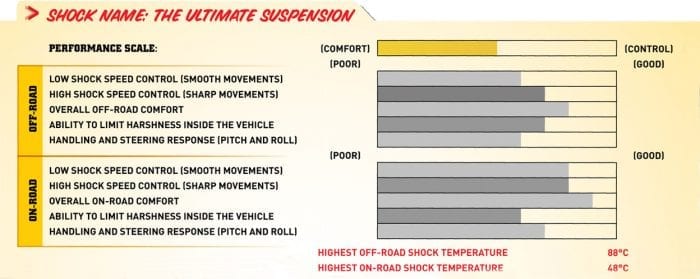
BRUCE’S OPINION: These shocks worked well with the vehicle, giving a nice controlled balance without being too firm. At slow speeds off-road, these shocks really worked a treat soaking up the terrain slightly more than others. On some of the quicker sections of the track, a small trade-off to the softer ride was as the shocks began to move faster through their stroke, they did allow the ’Cruiser to pitch and roll a little more than the others when they faced off-camber crests. If you don’t mind a softer feel from inside the vehicle, then these shocks would serve you well.
SHOCK NAME: TJM – XGS GOLD LIMITED EDITION
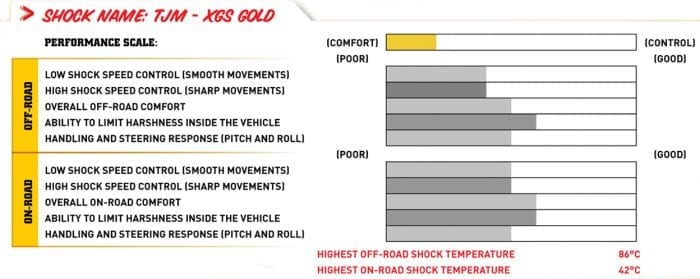
BRUCE’S OPINION: This set of shocks is by far one of the softest-feeling shocks over the bumps. In the driver’s seat, the shocks didn’t inspire confidence when you asked them to control the weight of the ’Cruiser along the track. If you’re looking for a particularly softer ride, these shocks would suit your style. Out of the variety of terrains we pushed them through, they were most at home over the low speed off-road tracks.
SHOCK NAME: TOUGH DOG
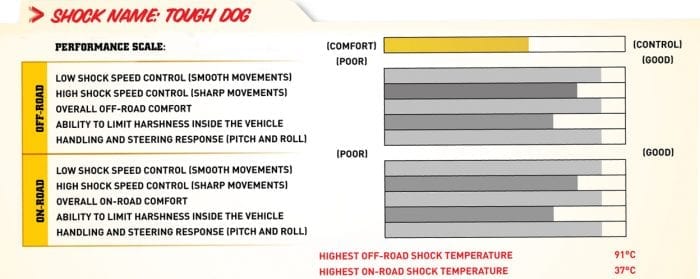
BRUCE’S OPINION: From the moment we drove out from the fitting bay, I knew there was something impressive underneath the ’Cruiser. They gave the ’Cruiser almost unmatched pitch balance front to rear that controlled the vehicle superbly where other shocks were simply unsettled. They were able to soak up the uneven ground with ease without ever letting the vehicle skip across the track. They gave a satisfying amount of confidence to the driver and always stayed predictable even across the roughest sections of the track. The balance of comfort inside the vehicle and driver control was ideal. Soft enough to soak up the rough stuff, while remaining stiff enough to give you plenty of confidence behind the wheel.
THE VERDICT
Whether it’s driving to the limits on tough off-road tracks or long-distance touring that gets you going, your shocks will need to be up to the task. Without a good set of shocks under vehicle, you could be risking your tyres leaving the ground unnecessarily. Not only will this result in a loss of traction, but it can be downright dangerous when you’re travelling at speed. A lot of factors that we all regard as good suspension characteristics rest on the shoulders of our shock absorbers. So, it pays to give them some attention before we come undone on the track. The back to back, real world and controlled environment testing in this comparo brought out some interesting differences between the shocks. The shocks had nowhere to hide with Bruce Garland behind the wheel. The variation in characteristics we picked up between the shocks are things the average 4WDer would feel from inside the vehicle, either as a driver or passenger. Given that every 4WDer has a preference to the way a vehicle feels behind the wheel, it was one of our most difficult comparos to rate. With price, on- and off-road performance and long-term durability in mind, we were able to crown the Tough Dog 41mm Bore Foam Cell as the Best Overall Shock, but it did have some pretty serious competition along the way. Koni, Old Man Emu, Bilstein and Raw 4X4 were all wrestling with Tough Dog for the top spot. The superb handling characteristics of the Bilstein helped it come away as the Best Handling Shock, while the Terrain Tamer Premium Heavy Duty shock took out the Most Affordable Shock. Ultimately, we’ve aimed to highlight each shock’s strengths and weaknesses to help you decide what best suits your driving style.
